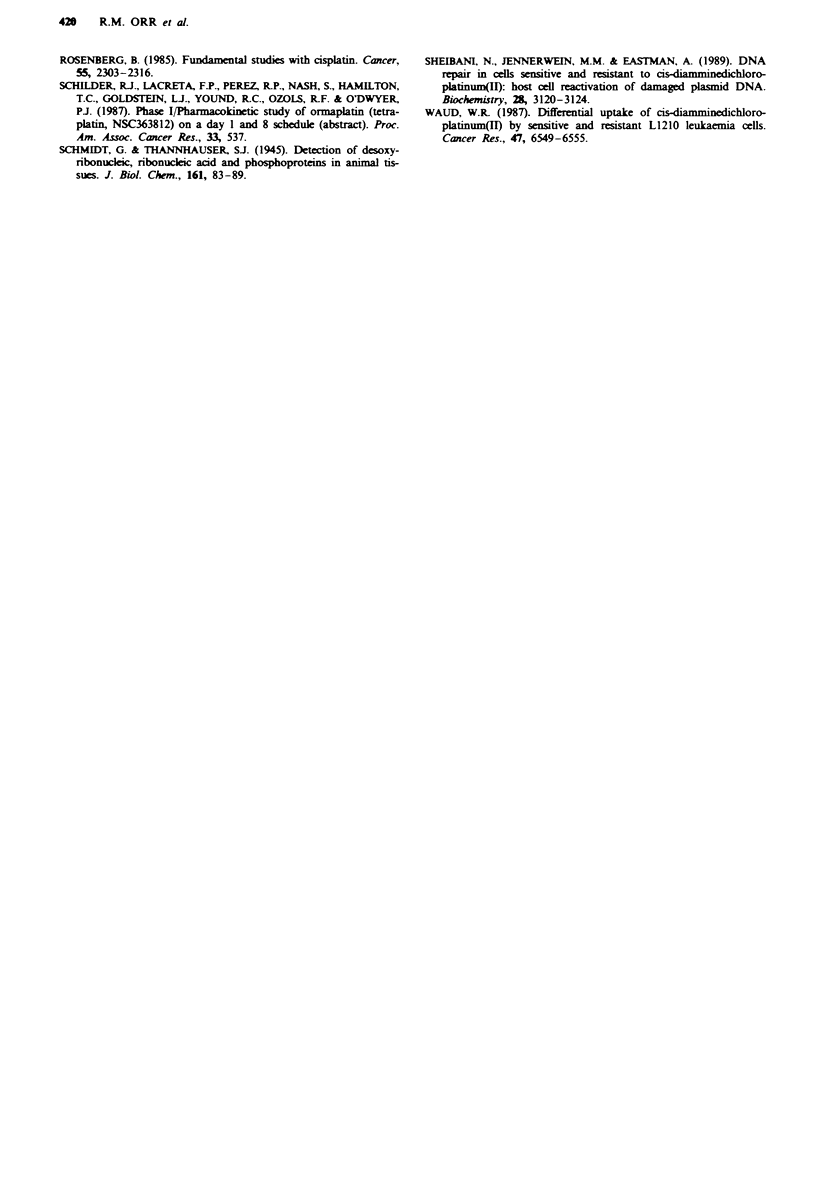Abstract
Seventeen alkylamine ammine dicarboxylatodichloroplatinum(IV) complexes of general structure c,t,c-[PtCl2(OCOR1)2NH3(RNH2)], where R = aliphatic or alicyclic and R1 = aliphatic or aromatic, have been evaluated against L1210 cell lines with acquired resistance to cisplatin (10-fold), tetraplatin (34-fold) or carboplatin (14-fold) using an in vitro growth-delay assay. All of these compounds overcame cisplatin, tetraplatin and carboplatin resistance. Potency increased as the number of carbon atoms in the axial aliphatic ligands (R1) increased, for example comparing JM216 (R = cyclohexyl, R1 = CH3, IC50 = 1.2 microM) with JM274 (R = cyclohexyl, R1 = n-C4H9, IC50 = 0.05 microM) against the parent sensitive line (L1210/S). The most active compounds were those possessing aromatic ligands at R1, regardless of whether R = aliphatic or alicyclic, for example JM244 (R = n-C3H7, R1 = C6H5, IC50 = 0.028 microM) and JM2644 (R = c-C6H11, R1 = C6H5, IC50 = 0.031 microM) against L1210/S. For an alicyclic alkylamine series in which R is varied from c-C3H7 to C-C7H13, with R1 = n-C3H7 for each compound, cytotoxic potency was maximised at c-C6H11 (JM221, IC50 = 0.06 microM against L1210/S). Preliminary biochemical studies, at equitoxic doses, comparing JM221 (0.1 microM) with cisplatin (0.6 microM) identified five times more platinum associated with JM221 treated cells and 1.5 times more platinum bound to the DNA of JM221-treated cells. The lipophilic properties of some of these platinum(IV) dicarboxylates may contribute to both the potency and circumvention of resistance by these compounds.
Full text
PDF





Selected References
These references are in PubMed. This may not be the complete list of references from this article.
- BURTON K. A study of the conditions and mechanism of the diphenylamine reaction for the colorimetric estimation of deoxyribonucleic acid. Biochem J. 1956 Feb;62(2):315–323. doi: 10.1042/bj0620315. [DOI] [PMC free article] [PubMed] [Google Scholar]
- Bramwell V. H., Crowther D., O'Malley S., Swindell R., Johnson R., Cooper E. H., Thatcher N., Howell A. Activity of JM9 in advanced ovarian cancer: a phase I-II trial. Cancer Treat Rep. 1985 Apr;69(4):409–416. [PubMed] [Google Scholar]
- Burchenal J. H., Kalaher K., Dew K., Lokys L. Rationale for development of platinum analogs. Cancer Treat Rep. 1979 Sep-Oct;63(9-10):1493–1498. [PubMed] [Google Scholar]
- Farnworth P., Hillcoat B., Roos I. Metallothionein-like proteins and cell resistance to cis-dichlorodiammineplatinum(II) in L1210 cells. Cancer Chemother Pharmacol. 1990;25(6):411–417. doi: 10.1007/BF00686051. [DOI] [PubMed] [Google Scholar]
- Gibbons G. R., Wyrick S., Chaney S. G. Rapid reduction of tetrachloro(D,L-trans)1,2-diaminocyclohexaneplatinum(IV) (tetraplatin) in RPMI 1640 tissue culture medium. Cancer Res. 1989 Mar 15;49(6):1402–1407. [PubMed] [Google Scholar]
- Gottlieb J. A., Drewinko B. Review of the current clinical status of platinum coordination complexes in cancer chemotherapy. Cancer Chemother Rep. 1975 May-Jun;59(3):621–628. [PubMed] [Google Scholar]
- Harrap K. R. Preclinical studies identifying carboplatin as a viable cisplatin alternative. Cancer Treat Rev. 1985 Sep;12 (Suppl A):21–33. doi: 10.1016/0305-7372(85)90015-5. [DOI] [PubMed] [Google Scholar]
- Hromas R. A., North J. A., Burns C. P. Decreased cisplatin uptake by resistant L1210 leukemia cells. Cancer Lett. 1987 Aug;36(2):197–201. doi: 10.1016/0304-3835(87)90091-7. [DOI] [PubMed] [Google Scholar]
- KIRBY K. S. ISOLATION AND CHARACTERIZATION OF RIBOSOMAL RIBONUCLEIC ACID. Biochem J. 1965 Jul;96:266–269. doi: 10.1042/bj0960266. [DOI] [PMC free article] [PubMed] [Google Scholar]
- Kelland L. R., Murrer B. A., Abel G., Giandomenico C. M., Mistry P., Harrap K. R. Ammine/amine platinum(IV) dicarboxylates: a novel class of platinum complex exhibiting selective cytotoxicity to intrinsically cisplatin-resistant human ovarian carcinoma cell lines. Cancer Res. 1992 Feb 15;52(4):822–828. [PubMed] [Google Scholar]
- Kraker A. J., Moore C. W. Accumulation of cis-diamminedichloroplatinum(II) and platinum analogues by platinum-resistant murine leukemia cells in vitro. Cancer Res. 1988 Jan 1;48(1):9–13. [PubMed] [Google Scholar]
- Krakoff I. H. Nephrotoxicity of cis-dichlorodiammineplatinum(II). Cancer Treat Rep. 1979 Sep-Oct;63(9-10):1523–1525. [PubMed] [Google Scholar]
- Mangioni C., Bolis G., Pecorelli S., Bragman K., Epis A., Favalli G., Gambino A., Landoni F., Presti M., Torri W. Randomized trial in advanced ovarian cancer comparing cisplatin and carboplatin. J Natl Cancer Inst. 1989 Oct 4;81(19):1464–1471. doi: 10.1093/jnci/81.19.1464. [DOI] [PubMed] [Google Scholar]
- Nicolson M. C., Orr R. M., O'Neill C. F., Harrap K. R. The role of platinum uptake and glutathione levels in L1210 cells sensitive and resistant to cisplatin, tetraplatin or carboplatin. Neoplasma. 1992;39(3):189–195. [PubMed] [Google Scholar]
- Ozols R. F., Young R. C. Chemotherapy of ovarian cancer. Semin Oncol. 1984 Sep;11(3):251–263. [PubMed] [Google Scholar]
- Pendyala L., Arakali A. V., Sansone P., Cowens J. W., Creaven P. J. DNA binding of iproplatin and its divalent metabolite cis-dichloro-bis-isopropylamine platinum (II). Cancer Chemother Pharmacol. 1990;27(3):248–250. doi: 10.1007/BF00685722. [DOI] [PubMed] [Google Scholar]
- Pendyala L., Cowens J. W., Chheda G. B., Dutta S. P., Creaven P. J. Identification of cis-dichloro-bis-isopropylamine platinum(II) as a major metabolite of iproplatin in humans. Cancer Res. 1988 Jun 15;48(12):3533–3536. [PubMed] [Google Scholar]
- Richon V. M., Schulte N., Eastman A. Multiple mechanisms of resistance to cis-diamminedichloroplatinum(II) in murine leukemia L1210 cells. Cancer Res. 1987 Apr 15;47(8):2056–2061. [PubMed] [Google Scholar]
- Rose W. C., Schurig J. E., Huftalen J. B., Bradner W. T. Antitumor activity and toxicity of cisplatin analogs. Cancer Treat Rep. 1982 Jan;66(1):135–146. [PubMed] [Google Scholar]
- Rosenberg B. Fundamental studies with cisplatin. Cancer. 1985 May 15;55(10):2303–23l6. doi: 10.1002/1097-0142(19850515)55:10<2303::aid-cncr2820551002>3.0.co;2-l. [DOI] [PubMed] [Google Scholar]
- Sheibani N., Jennerwein M. M., Eastman A. DNA repair in cells sensitive and resistant to cis-diamminedichloroplatinum(II): host cell reactivation of damaged plasmid DNA. Biochemistry. 1989 Apr 4;28(7):3120–3124. doi: 10.1021/bi00433a055. [DOI] [PubMed] [Google Scholar]
- Waud W. R. Differential uptake of cis-diamminedichloroplatinum (II) by sensitive and resistant murine L1210 leukemia cells. Cancer Res. 1987 Dec 15;47(24 Pt 1):6549–6555. [PubMed] [Google Scholar]


